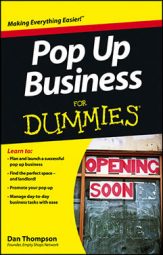After your pop up's brand is ready and your designs are created, you can move on to printing. The type of print you use depends on the print run – that is, the number of items you need to have printed.
Don’t go to print until you’re sure that you like the designs and be careful to proofread everything carefully. Asking somebody who’s not directly involved to proofread your leaflets is always worthwhile; you’ll be surprised what you can miss because you’re so close to the project.
Many printing techniques exist, but the ones you’re most likely to need for your pop up are:
Desktop publishing. This technique is ideal for very short runs. As long as you have a reasonable quality printer, you can produce artwork up to A3 size from your own computer.
Printer ink is very expensive, so using your own printer isn’t a good idea for print runs that are longer than a few pages! Of course, using your own printer you can customise every single page if you want to. If you need to print more than 25 sheets, use a commercial printer or a copy shop.
Copy shops. These can produce short runs of leaflets and posters and can provide extra services such as laminating, trimming or binding. They’re not cost-effective for larger runs, though. Copy shops are good for things like newsletters and black-and-white flyers.
They can also enlarge black-and-white A4 artwork to much larger poster sizes at low cost, which can create some striking visuals in your pop up. Copy shops can also produce full-colour designs in very short runs, such as VIP invites or posters and are most cost-effective for runs of 25 to 100.
Offset lithography, or litho for short. This is a high-quality technique, and you can carefully match the colours to your artwork. Litho is only cost-effective on larger print runs because the printer makes a plate from your artwork, which is expensive. Litho is the domain of professional printers.
Digital print. This technique is more cost-effective for shorter runs, but the standard isn’t as high as with litho. Digital print can also be turned around quickly and easily. You can personalise digital print – for example, adding customers’ names and addresses.
Letterpress printing and screen printing. These once mainstream commercial printing techniques have now fallen out of use commercially but are still practised as an art. They produce distinct, stylish results but have a higher cost. Letterpress has limited options for design, as you have to use existing typefaces. Screen printing isn’t suitable for smaller type.
The cost of print varies depending on:
Print run
Print process
Paper type
Special requirements
Work out exactly what you need printed and then consider which is the best and most cost-effective way to do so. For runs of about 1,000 full-colour flyers, take the time to shop online. Print brokers, such as Expect to spend at least 10 per cent of your pop up’s total budget on design and print.

